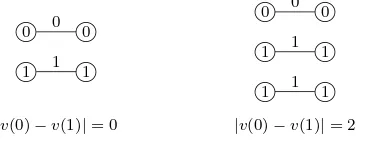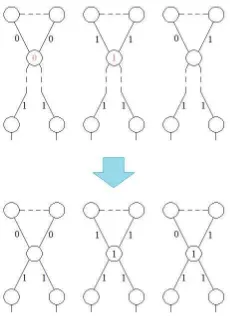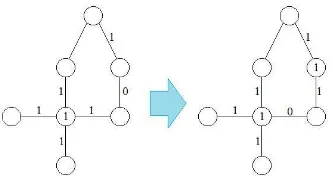Special Edition (2011), pp. 27–38.
ON THE EDGE-BALANCE INDEX SETS OF
L
-PRODUCT OF CYCLES
Daniel Bouchard
1, Patrick Clark
2, and Hsin-Hao Su
31 whether there are more 0-edges or 1-edges incident withv, and no label is given tof+(v) otherwise. For eachi∈Z
≤1 . The edge-balance index set of the graph G is defined as
EBI(G) =
vf(0)−vf(1)
:f is edge-friendly. . In this paper, exact values of the edge-balance index sets ofL-product of cycles with cycles,Cn×LCmare presented.
Key words: Edge labeling, edge-friendly labeling, cordiality, edge-balance index set,
L-products, cycles.
Abstrak. Misalkan G adalah graf sederhana dengan himpunan titik V(G) dan himpunan sisiE(G), dan misalkanZ2={0,1}. Setiap pelabelan sisifmenginduksi pelabelan titik parsialf+
:V(G)→Z2memberikan 0 atau 1 untukf+
(v), dengan
v titik diV(G), tergantung pada apakah terdapat lebih sisi-sisi-0 atau sisi-sisi-1 terkait dengan v, dan yang lain adalah tidak ada label diberikan untukf+
(v).
≤1 . Himpunan indeks seimbang-sisi dari graf G didefinisikan sebagaiEBI(G) =
vf(0)−vf(1)
:f adalah ramah-sisi}. Dalam paper ini dis-ajikan nilai-nilai eksak himpunan-himpunan indeks seimbang-sisi hasil-kali-Ldari lingkaran dengan lingkaran,Cn×LCm.
2000 Mathematics Subject Classification: 05C78, 05C25. Received: 09-08-2011, revised: 09-09-2011, accepted: 04-12-2011.
Kata kunci: Pelabelan sisi, pelabelan ramah-sisi, kordialitas, himpunan indeks seimbang-sisi, hasil-kali-L, lingkaran.
1. Introduction
In [8], Kong and Lee considered a new labeling problem of graph theory. Let Gbe a simple graph with vertex setV(G) and edge setE(G), and letZ2={0,1}. An edge labeling f :E(G)→Z2 induces a vertex partial labelingf+:V(G)→Z
2
defined byf+(v) = 0 if the edges labeled 0 incident onvis more than the number
of edges labeled 1 incident onv, andf+(v) = 1 if the edges labeled 1 incident onv
is more than the number of edges labeled 0 incident onv. f+(v) is not defined if the
number of edges labeled by 0 is equal to the number of edges labeled 1. Fori∈Z2,
letvf(i) =|{v∈V(G) :f+(v) =i}|, and letef(i) =|{e∈E(G) :f(e) =i}|.
With these notations, we now introduce the notion of an edge-balanced graph.
Definition 1.1. An edge labeling f of a graphG is said to be edge-friendlyif
|ef(0)−ef(1)| ≤1. A graph G is said to be an edge-balanced graph if there is
an edge-friendly labelingf ofGsatisfying |vf(0)−vf(1)| ≤1.
Chen, Lee, et al in [2] proved that all connected simple graphs except the starK1,2k+1, wherek≥0 are edge-balanced.
Definition 1.2. The edge-balance index setof the graphG, EBI(G), is defined as{|vf(0)−vf(1)|:the edge labeling f is edge-friendly.}.
We will usev(0),v(1),e(0),e(1) instead ofvf(0),vf(1),ef(0),ef(1), provided
there is no ambiguity.
Example 1. EBI (nK2) is{0} ifnis even and{2}ifnis odd. ✷
✐ ✐
1 1 1
✐ ✐
0 0 0
|v(0)−v(1)|= 0
✐ ✐
1 1 1
✐ ✐
1 1 1
✐ ✐
0 0 0
|v(0)−v(1)|= 2
Figure 1. The edge-balance index sets of 2K2 and 3K2.
For any n ≥ 1, we denote the tree with n+ 1 vertices of diameter two by St(n). The star has a centercandnappended edges fromc.
Example 2. The edge-balance index set of the star St(n) is
EBI (St(n)) =
(
{0} ifnis even,
✷
Example 3. In [16], Lee, Lo and Tao showed that
EBI (Pn) =
Example 4. Figure 3 shows that the edge-balance index set of a tree with six
vertices is{0,1,2}. ✷
Figure 3. The edge-balance index set of a tree with six vertices.
Edge-balance index sets of trees, flower graphs and (p, p+ 1)-graphs were considered in [10, 16, 18].
Definition 1.3. Let H be a connected graph with a distinguished vertex s. Con-struct a new graphG×L(H, s)as follows: take|V(G)|copies of(H, s)and identify
each vertex of G with s of a single copy of H. We call the resulting graph the L-product ofGand(H, s).
Note here that, in [7], Koh, Rogers and Tan defined the same graph operation and used the notationG△H, instead ofG×L(H, s).
In a series of papers [1, 5], Chou et al. investigated the edge-balance index sets ofL-product of cycles with stars, Cn×L(St(m), c)). The edge-balance index
ofL-product of graphs are also considered in [6]. In this paper, exact values of the edge-balance index sets ofL-product of cycles with cycles,Cn×LCm, are presented.
2. The Highest Edge-balance Index
In order to find the full set of the edge-balance indexes, we begin by finding the highest edge-balance index first. The following notations and propositions are borrowed from [3]. You can also find them in [4].
Notation 1. LetCnbe a cycle with a vertex set{c1, c2, . . . , cn}. Letf :E(Cn)→ Z2 be an edge labeling on Cn (not necessarily edge-friendly), whereE(Cn) is the
edge set of Cn. We denote the numbers of edges labeled 0 or 1 by f by eC(0)
or eC(1), respectively. We also denote the number of vertices labeled 0, 1, or not
labeled byf+ byv
C(0),vC(1), orvC(×), respectively.
Proposition 2.1. In a cycle Cn with an edge labeling f (not necessarily
edge-friendly), assume thatvC(×) = 2k >0. Then
vC(1) =eC(1)−k.
Proposition 2.2. In a cycle Cn with an edge labeling f (not necessarily
edge-friendly), assume thatvC(×) = 2k >0. Then
vC(0) =n−eC(1)−k.
We note here that whenvC(×) = 0, i.e., either eC(0) =noreC(1) =n, the
above propositions are still true.
Theorem 2.3. In a finite disjoint union of cycles ∪iCnii (for notational conve-nience, we still call itC) with an edge labelingf (not necessarily edge-friendly), we have
vC(0)−vC(1) =
X
i
ni−2eC(1).
We note here that, for a Cn×LCm graph, since there are exactlyn outer
cycles withmvertices each, it follows thatX
i
ni =nm. In general, it is also true
that e(Cn×LCm) =n(m+ 1).
If we remove all edges ofCnfrom aCn×LCmgraph, we have a disjoint union
of Cm cycles. For convenience, let us callCn the inner cycle and all copies ofCm
the outer cycles. We also call the edges of Cn inner edges and the edges of Cm
outer edges.
Theorem 2.3 suggests thatvC(0)−vC(1) is maximized wheneC(1) is
mini-mized. In order to minimizeeC(1), we label all the edges ofCn with 1’s.
We now consider thennumber of degree 4 vertices, each with two 1-labeled edges from Cn and two currently unlabeled edges from their respective Cm
cy-cle. Ignoring any edge-friendly labeling restriction for the moment, there are three possible cases to consider in labeling the last two edges of one of the outer cycles:
(1) One edge is labeled 0 and the other 1; (2) Both edges are labeled with 0’s; (3) Both edges are labeled with 1’s.
In order to maximizevC(0)−vC(1) in Theorem 2.3, we maximizevC(0) and
minimize vC(1) at the same time. Consider any single outer cycle by itself,
unat-tached to the inner cycleCn, with each of our three possible labeling choices above.
Under the first choice, the unattached outer cycle’s vertex would be unlabeled and attaching it toCn will change the vertex to a 1, a net gain of one 1-vertex. With
the second choice, the unattached outer cycle’s vertex would be labeled 0 and at-taching it toCnwould result in an unlabeled vertex, a net loss of one 0-vertex. The
third choice yields a vertex labeling of 1 on the unattached outer cycle and still a 1-vertex when attached toCn.
We see that only the third choice keeps the edge-balance index unchanged. The other two choices reduce it by 1. Therefore, it follows that, in order to maximize vC(0)−vC(1), we want to label the remaining edges adjacent to the degree 4 vertices
with 1’s.
By Theorem 2.3, the remaining unlabeled edges of our graph can be labeled in any assortment and, as long as the labeling is friendly, it yields the highest edge-balance index. However, for the purposes of the later proofs, we require that in each outer cycle at least one of the edges adjacent to the 4 degree vertex is also adjacent to a 0-edge.
Figure 4. The change of the labels of the order 4 vertices.
degree vertices in the outer cycles. In order to guarantee there are enough 1-edges, mmust be 5 or greater.
Theorem 2.4. The highest edge-balance index of Cn×LCmform≥5 is
n ifm is odd;
n ifn is even;
n+ 1 ifn is odd andm is even.
Proof. Ifn is even, then we assumen= 2s, where s∈N. The number of edges
is thene(Cn×LCm) = 2s(m+ 1). Therefore,e(0) =e(1) =s(m+ 1). After using
our suggested labeling, we have
eC(1) =e(1)−n=s(m+ 1)−2s=sm−s.
Since Cn provides no new vertices to what would be the disjoint union of
outer cycles and with our labeling no vertices are changed whether the cycles are connected or disconnected, by Theorem 2.3, we have the highest edge-balance index
v(0)−v(1) =nm−2eC(1) = 2sm−2(sm−s) = 2s=n.
Similarly, whenm is odd, we assume m = 2t+ 1, where t ∈N. Since it is
wheres∈N. The number of edges is thene(Cn×LCm) = (2s+1)(2t+2). Therefore,
we have e(0) =e(1) = (2s+ 1)(t+ 1). After using our suggested labeling, we have
eC(1) =e(1)−n= (2s+ 1)(t+ 1)−(2s+ 1) = 2st+t.
Thus, the highest edge-balance index whenmis odd is
v(0)−v(1) =nm−2eC(1) = (2s+ 1)(2t+ 1)−2(2st+t) = 2s+ 1 =n.
Finally, fornis odd andmis even, we assume thatn= 2s+ 1 andm= 2t, where s, t ∈N. The number of edges is then e(Cn×LCm) = (2s+ 1)(2t+ 1) =
4st+2t+2s+1 = 2(2st+t+s)+1. Sincee(Cn×LCm) is odd, due to the symmetric
roles of 0 and 1 in the edge-balance labeling, without loss of generality, we may assume that e(1) ≤ e(0). Therefore, we can see that e(0) = 2st+t+s+ 1 and e(1) =e(1)−n= 2st+t+s. After using our suggested labeling, we have
eC(1) = 2st+t+s−(2s+ 1) = 2st+t−s−1.
Thus, the highest edge-balance index whennis odd andmis even is
v(0)−v(1) =nm−2eC(1) = (2s+ 1)(2t)−2(2st+t−s−1) = 2s+ 2 =n+ 1.
This completes the proof. ✷
3. The Edge-Balance Index Set ofCn×LCm form≥5
From Theorem 2.4, we can conclude that
Corollary 3.1. The edge-balance index set ofCn×LCmform≥5 is a subset of
{0,1,2, . . . , n} ifm is odd;
{0,1,2, . . . , n} ifn is even;
{0,1,2, . . . , n+ 1} ifn is odd andm is even.
In order to show that the edge-balance index set ofCn×LCmcontains all the
numbers less then the highest edge-balance index, we observe from our suggested edge labeling that we can switch a 0-edge we specified to be adjacent to one of the 1-edges which are adjacent to the 4 degree vertex in the outer cycle. Both cases are demonstrated in the Figures 5 and 6.
We can see that, no matter the edge adjacent to the 0-edge is labeled 0 or 1, this reduces the current edge-balance index by exactly 1, each time it is done to an outer cycle. This strategy enables us to prove that
Theorem 3.2. The edge-balance index set ofCn×LCm form≥5is
EBI(Cn×LCm) =
{0,1,2, . . . , n} ifm is odd;
{0,1,2, . . . , n} ifn is even;
Figure 5. Switching edges when the adjacent edge is labeled 0.
Figure 6. Switching edges when the adjacent edge is labeled 1.
Proof. When m is odd or n is even, since there are n outer cycles, the above strategy provides the edge-balance indexes fromn−1 all the way to 0. Therefore, the edge-balance index set is {0,1,2, . . . , n}.
Whenn is odd and m is even, a similar process of n outer cycles can only provides the edge-balance index to be any integer between n and 1. Thus, the edge-balance index set contains{1,2,3, . . . , n+ 1}.
To show EBI(Cn×LCm) whennis odd and mis even includes 0 as well, a
entirely new labeling is necessary. Sincenis odd, we may assume thate(0)> e(1) due to symmetry. First, we label 0,1,0,1,0,1, . . . ,0,1,0 to the edges of inner cycle. Since nis odd, the very last label in the sequence must be 0. Thus, there is only one vertex, namelyv, in the inner cycleCnto have two 0-edges as of now. Because
vertex is labeled 1. Therefore, for the whole edge-balance labeling, we have only one 0-vertex and one 1-vertex. All other vertices are unlabeled. It provides an
edge-balance index 0. ✷
4. The Edge-balance Index Set ofCn×LCm when m is3 or 4.
Whenm is 3 or 4, as discussed before, we do not have enough number of 1-edges to be placed in outer cycles to avoid reducing the highest edge-balance index while putting back 1-edges for the inner cycle. But, we can still pair 1-edges to keep the label of the order 4 vertices unchanged as many as possible to produce the highest edge-balance index.
Theorem 4.1. The highest edge-balance index of Cn×LC4 is
( ⌊3k
2⌋ if n= 2k is even;
⌊3k+1
2 ⌋+ 1 if n= 2k+ 1is odd.
Proof. Whenn= 2kis even, the total number of edges ofCn×LC4 is 5n= 10k.
Thus, in an edge-balance labeling, there are 5k 1-edges. As in section 2, with Theorem 2.3, we maximize the edge-balance index by labeling all inner cycle edges 1. This requiresn= 2k 1-edges. Therefore,eC(1) = 3k. So, we have⌊32k⌋1-edges
pairs to be placed in the outer cycle edges of the order 4 vertices. According to the Figure 4, the other two cases cause a reduction by 1 for the edge-balance index. It affects n− ⌊3k
2⌋labels of the order 4 vertices. The highest edge-balance index
becomes
e(0)−e(1) = X
i
ni−2eC(1)−(the number of the reduced labels)
= 4n−2eC(1)−
n− ⌊3k
2 ⌋
= 4(2k)−2 (3k)−
2k− ⌊3k
2 ⌋
= ⌊3k
2 ⌋.
Whenn= 2k+1 is odd, the total number of edges ofCn×LC4is 5n= 10k+5.
highest edge-balance index is reduced byn− ⌊3k+1
Proof. When n is even, by Theorem 4.1, we see that the highest edge-balance index is⌊3k
2⌋. This number also represents the number of order 4 vertices with all
four edges labeled 1. Therefore, the same switching strategy from Figure 5 and 6 can produce the edge-balance index for any number between⌊3k
2⌋ −1 and 0.
Similarly, whenn is odd, the number of order 4 vertices with all four edges labeled by 1 for switching is enough to produce the edge-balance indexes for any number between⌊3k+1
2 ⌋and 1.
A similar edge-labeling as the one in the last paragraph of the proof of Theo-rem 3.2 shows that EBI(Cn×LC4) whennis odd includes 0 as well. This completes
in a edge-balance labeling, there are 2n1-edges. Similarly, we usen1-edges to label all inner edges in order to maximize the edge-balance index. Therefore,eC(1) =n.
So, we have⌊n
2⌋1-edges-pairs to be placed in the outer cycle edges of the order 4
vertices. According to the Figure 4, the other two cases causes a reduction by 1 for the edge-balance index. It affects n− ⌊n
highest edge-balance index becomes
The number of order 4 vertices with all four edges labeled by 1 is⌊n
2⌋.
There-fore, the same switching strategy from Figure 5 and 6 can produce the edge-balance index for any number between⌊n
2⌋ −1 and 0.
This completes the proof. ✷
AcknowledgmentWe would like to thank the Stonehill Undergraduate Research Experience (SURE) program for supporting and funding during summer 2010 to make this paper possible.
We would also like to thank the referee for the thorough, constructive and helpful comments and suggestions on the manuscript. Thank you very much for sharing your opinion and advice.
References
[1] Bouchard, B. Clark, P. and Su, H.H. ”On Edge-Balance Index Sets of theL-product of Cycles with Stars, Part II”, to appear inJ. Combin. Math. Combin. Comput.
[2] Chen, B.L. Huang, K.C. Lee, S.M. and Liu, S.S. ”On Edge-balanced Multigraphs”, J. Combin. Math. Combin. Comput.,42(2002), 177-185.
[3] Chopra, D. Lee, S.M. and Su, H.H. ”On Edge-balance Index Sets of Wheels”, Int. J. of Contemp. Math. Sci.,5(2010), no. 53, 2605-2620.
[4] Chopra, D. Lee, S.M. and Su, H.H. ”On Edge-balance Index Sets of Fans and Broken Fans”,
Congr. Numer.,196(2009), 183-201.
[5] Chou, C-C. Galiardi, M. Kong, M. Lee, S.M. Perry, D. and Su, H.H. ”On Edge-Balance Index Sets of theL-product of Cycles with Stars, Part I”, to appear inJ. Combin. Math. Combin. Comput.
[6] Galiardi, M. Perry, D. and Su, H.H. ”On the Edge-Balance Index Sets of the Flux Capacitors and L-product of Stars with Cycles”, to appear inJ. Combin. Math. Combin. Comput.
[7] Koh, K.M. Rogers, D.G. and Tan, T. Two theorems on graceful trees,Discrete Math.,25
(1979), 141–148.
[8] Kong, M.C. and Lee, S.M. ”On Edge-Bananced Graphs”, inProceedings of the7th quadren-nial international conference on the theory and applications of graphs, vol2, 712-722, John Wiley and Sons, Inc. 1993.
[9] Kwong, H. and Lee, S.M. ”On Balance Index Sets of Chain Sum and Amalgamation of Generalized Theta Graphs”,Congr. Numer.,187(2007), 21–32.
[10] Kwong, H. and Lee, S.M. ”On Edge-balance Index Sets of Flower Graphs”, unpublished manuscript.
[11] Kwong, H. Lee, S.M. Lo, S.P.B. Su, H.H. and Wang, Y.C. ”On Balance Index Sets of
L-Products with Cycles and Complete Graphs”,J. Combin. Math. Combin. Comput.,70
[12] Kwong, H. Lee, S.M. and Sarvate, D.G. ”On Balance Index Sets of One-point Unions of Graphs”,J. Combin. Math. Combin. Comput.,66(2008), 113-127.
[13] Lee, A.N.T. Lee, S.M. and Ng, H.K. ”On Balance Index Sets of Graphs,J. Combin. Math. Combin. Comput.,66(2008), 135-150.
[14] Lee, S.M. Chen, B. and Wang, T. ”On the Balanced Windmill Graphs”,Congr. Numer.,
186(2007), 9-32.
[15] Lee, S.M. Liu, A.C. and Tan, S.K. ”On Balanced Graphs”, Congr. Numer., 87 (1992), 59-64.
[16] Lee, S.M. Lo, S.P.B. and Tao, M.F. ”On the Edge-balance Index Sets of Some trees”, unpublished manuscript.
[17] Lee, S.M. Ng, H.K. and Tong, S.M. ”On the Balance Index Set of the Chain-sum Graphs of Cycles”,Utilitas Math.,77(2008), 113-123.
[18] Lee, S.M. Su, H.H. and Wang, Y.C. ”On Edge-balance Index Sets of (p, p+ 1)-graphs, unpublished manuscript.
[19] Lee, S.M. Su, H.H. and Wang, Y.C. ”On Balance Index Sets of the Disjoint Union Graphs”,
Congr. Numer.,199(2009), 97-120.
[20] Seoud, M.A. and Abd el Maqsoud, A.E.I. ”On Cordial and Balanced Labelings of Graphs”,



